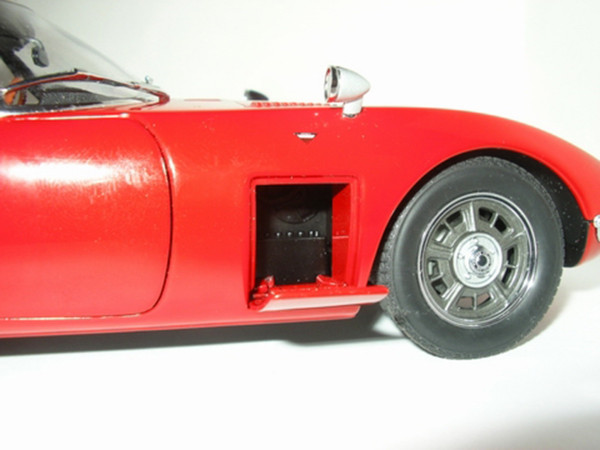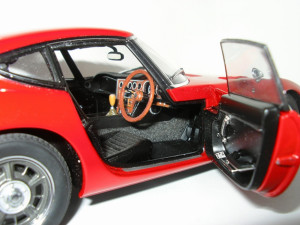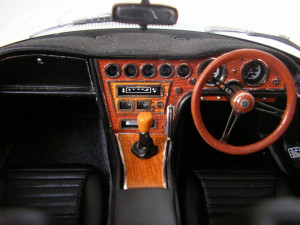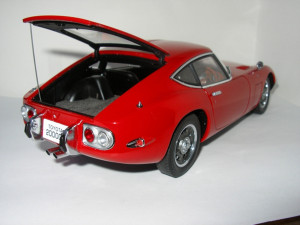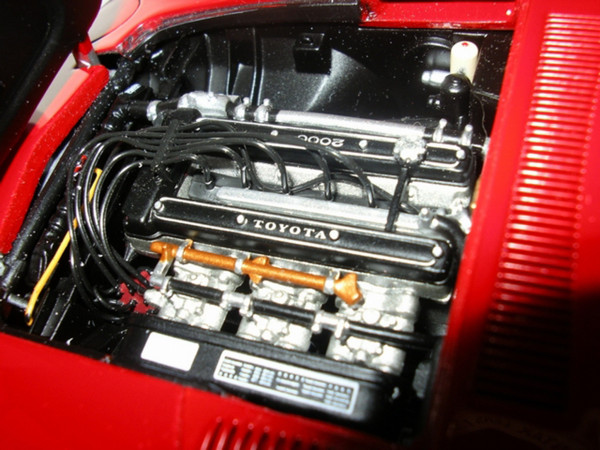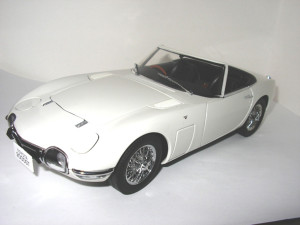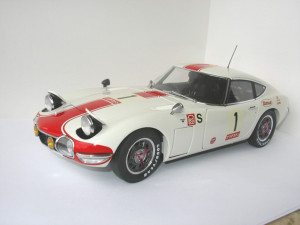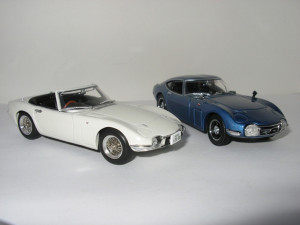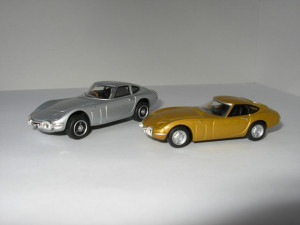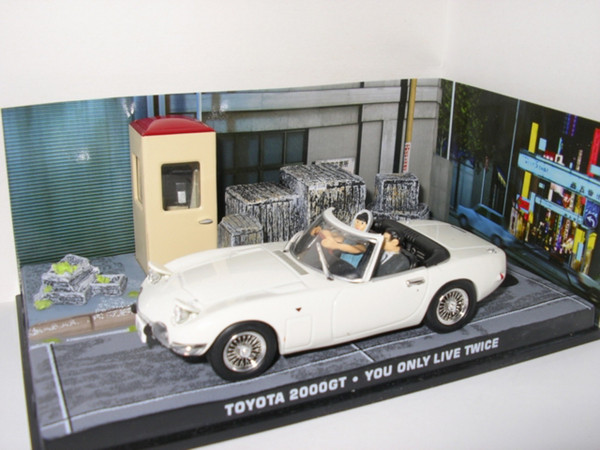Amongst the variety of themes in my collection lurks a vast hoard of Toyotas. I guess having worked with, driven, and owned them for the last 25 years causes some affinity to develop. The thing is, even as much as you like all of them, one or two always manage to capture your imagination and cause you to pause an extra minute or two as they wow you and cause you to deepen your level of admiration of them. For me, one such car is the Toyota 2000GT. Produced in only very small numbers, in fact a grand total of 337 vehicles, and as a bold exercise by a Japanese company in the mid-sixties, it is amazing that it ever got produced at all. How about a short history lesson?
HISTORY
One has to remember that in the 1960’s Japanese car manufacturers were starting to emerge as makers of quality affordable cars, and having found their feet and having established themselves at home, they were starting to look abroad for export opportunities. However, if you recall, most of the cars produced were staid, plain, family type cars, built for a purpose, and to a price. At this time, the prime movers in the Japanese car industry were Toyota, Nissan, Honda and Fuji Heavy Industries(Mazda) and most, seeing the impact the introduction of Sports Cars was having in Europe and the USA, started thinking about producing their own versions. This was a time when the world had been struck, jaws agape, by cars like the E-Type Jaguar, Aston Martin DB4/5, Lamborghini Miura, Ferrari 250GTO, and a host of other innovative and stylish Sports and GT type cars.
But this story actually starts with Nissan – arch rivals to Toyota. In around 1963, Nissan engaged the services of a German-American automotive designer, one Albrecht Goertz, who being keen to assist the Japanese in Sports Car manufacture, agreed to provide input and styling ideas, and within a short period of time had a basic design down on paper and ready for production approval. Goertz now enlisted the services of precision engineering company Yamaha – famous for manufacturing musical instruments and motorcycles, to produce a working prototype. Nissan were very impressed with the whole concept (remember that Nissan had already being dabbling with sports cars – remember the Datsun Fairlady?) and looked all set to produce the car but at the last minute got cold feet and pulled the pin on the whole deal, saying that perhaps they should stick to their knitting – producing & improving the bread & butter models they already had, leaving poor Yamaha holding the baby as it were.
Undeterred, Yamaha went to see Toyota, who had also started messing with Sports Cars (as had Honda – remember the Honda S600 & S800), and had already had success with the diminutive Toyota Sports 800 (but that’s another story). Toyota embraced the concept whole-heartedly, but wanted Yamaha to utilize body design work already developed in their own design studios. This was no big problem as Yamaha now realized that it would have access to all of Toyota’s considerable technology and so, was soon able to develop an engine using a current production inline six cylinder unit, resulting in Japans first production six cylinder DOHC engine using triple carburetors and a 5-speed gearbox, not to mention a whole host of other Japanese automotive “firsts”. Combine that mix with the Toyota designed body (note styling influences taken from the Jaguar E-Type), and in 1965 Toyota & Yamaha presented to the world the Toyota 2000GT at the Tokyo Motor Show to wide spread acclaim.
The whole exercise now turned out to be very lucrative for Yamaha, because to save themselves the expense of tooling up for production, Toyota contracted the manufacture of the new sports car back to Yamaha, signing off on the limited production run of just 337 units. Ironically Nissan, seeing the fulfillment of the dream that could have been theirs, then re-enlisted the services of Herr Goertz for another attempt and, as everyone knows, the similarities between the 2000GT and the Datsun 240Z, released just a few years later, are unmistakable. This brings us nicely to the model you see here.
The Models
Autoart have produced this 1:18 scale version of the Toyota 2000GT with an amazing amount of detail. To the sports car enthusiast, immediately evident is the bonnet to cabin proportion – a long bonnet and shorter coupe styled body – classic 60’s styling. Looking at the front you can see grille mounted headlamps and also the pop-up headlamps. The pop-up ones, it seems, had to be added to satisfy strict, yet cumbersome U.S safety regulations requiring headlamps to be 600mm off the ground! On this model they can be activated by a small lever under the front of the car. The next most obvious items would be the twin side hatches seen in the front guards. It seems that space was at a premium in the engine bay so these hatches were created to give access to the air cleaner and radiator header tank on the left hand side and the battery on the right. As can be seen, the chrome work and fittings are all precise in fit and proportion, even down to the wiper blade refills being depicted in matte black paint and which hug the contours of the curvaceous windscreen superbly. Also of interest is the front and rear bumper treatment. Actually they are basically over-riders without any horizontal bumper bar at all, apart from the two small bumperettes above the front indicator lamps. At the rear end, we find the tail light clusters enclosed in their satin finish bezels with all lens work depicted in proper coloured glass both front & rear - as befits a model to this standard. The paint finish is superb with no sign of ‘orange peel’ or blemish of any sort and sporting a deep shine – again to Autoart’s usual standard. Notice also the ventilation louvers just ahead of the windscreen and to the rear and either side of the bonnet – these are actually all properly formed and not painted-on decorations.
The opening tailgate lifts to reveal a nicely trimmed load bay area dressed with a ‘to scale’ look, flocking type material. Obviously, being a 2 seater, there is no rear seat in the vehicle. Typically, being a ‘60’s sports car, the interior is trimmed in black vinyl with glove box and door trims highlighted with correctly scaled, photo-etched chrome trim. The chrome trim also extends to the dash board itself, being applied to the instrument dial rings, center console and gear lever boot retainer ring. Of course there is the dashboard itself with its wood grain inserts. On the real car, real wood was used, being easily accessed by Yamaha engineers through access to their piano making facilities. The wood was also used on the gear knob, the steering wheel, and the curious ornamental piece between and behind the seats, which may be a small locker of some sort.
Turning the car over and seeing the underside reveals more typical Autoart detail. Clearly shown are all suspension and steering components, and also the chassis structure. This can be easily seen to be copied from the Lotus Elan being of a the single ‘backbone’ type structure with ‘Y’ legs at each end, supporting engine/gearbox units and rear axle assemblies respectively – another Japanese first, as was the fully independent rear suspension, and the four wheel disc brakes – all clearly visible and identifiable.
Finally, we can look beneath the bonnet (or hood!!) which tilts forward. Most obvious at first sighting is the brace of side-draft carburetors. These were Toyota’s Mikunis and enthusiasts will immediately see the resemblance to the Italian Weber (remember – the Japanese have always been known as the great imitators in many areas of technology and manufacturing!). The straight six DOHC engine is very well detailed, showing all plumbing, fuel hoses (with hose clamps, etc.) and spark plug leads. Even small items like the oil filler & radiator caps are painted up and engine bay decals are present too although, probably written in Japanese, they are too small to read.
So why was the Toyota 2000GT produced in such low numbers? Probably two reasons. Firstly, it seems Toyota never wanted full scale production in the first place, rather it wanted something to showcase to the world that it had better watch out! - Toyota was coming! This it proved by sending the 2000GT into a whole host of endurance tests and trials, setting numerous class endurance & speed records in the process and showing that this was no fragile, rose petal, Euro-box that needed cosseting and pampering lest it fall to pieces. This was borne out even further when the legendary Carrol Shelby was asked to race prepare, and thrash a couple of the cars on the race track for a couple of years. This he did, with a modicum of success too – until Toyota seeing the point proven, pulled the pin on that episode. Toyota even showed its prowess off to the Movie world by providing a couple of cars for the James Bond movie "You Only Live Twice". The only problem was that the star Sean Connery, being so tall, couldn’t fit comfortably in the car. So Toyota promptly sent in some Yamaha engineers who deftly “adapted” the cars to convertible status! Hence the existence of the white convertible as seen in the movie, and as a model ever since.
The second reason for low production was probably expense. It is thought that Toyota lost money on every car made. This is hardly surprising considering the manufacturing process. Here was a hand built (by Yamaha) sports car utilizing never-seen-before-in-Japan engineering & technology. This was the beginning of the Japanese super car. In fact, the 2000GT is the great-great grandfather of the present day Toyota Supra. 150 horsepower and 140 miles per hour were pretty scary in the mid-sixties, but the public must have got a taste for it because, only a few years later, the Datsun 240Z was unleashed. This was a proper production car, not as mechanically advanced, and built more conventionally and ruggedly, but yet the true Japanese sports car the world had been waiting for and so it proved to be a run-away success.
As far as models go, the Toyota 2000GT is fairly well catered for. I have 3 in 1:18 scale; the coupe and convertible, covered in detail here, and one of two race car versions as raced in the 1967 Fuji 24 hour, all produced by Autoart. Also available is a very nice 1:24 scale version by Japanese manufacturer Ebbro as part of their Gold Premier Collection, and this is also exquisitely detailed. Moving onto 1/43 scale, there is a coupe version in blue by Kyosho and a convertible version by Minichamps, both showing a nice amount of detail and correct proportions. Finally, I have a couple of small ones – both coupes, a silver one in 1:64 scale from Konami and a gold one in 1:72 scale from Tomica (Tomy), both Japanese companies.
I certainly don’t profess to have all variations made, in fact, far from it. The more established and perhaps more “senior” collectors among us would also be aware of the original Corgi version of the James Bond convertible, with weapons, etc., now becoming quite rare today. If you were fortunate enough to stumble across one nowadays you’d expect to pay around £300 for a MIB version with instruction sheet, etc. I think I’ll just settle for the new James Bond Collection version - just released in the part-work series, currently available at your local booksellers [2008]. In the U.S., where most of the production cars ended up, several of the main plastic model kit manufacturers produced versions of the 2000GT during the ‘60’s and ‘70’s as well. So as rare as this exotic Japanese Sports Car was, it has been captured and preserved for posterity, in great detail and in a variety of modeling guises, all to tempt the likes of us poor souls afflicted with a certain unquenchable passion. Long may it continue!!
Shayne Spicer
2012

